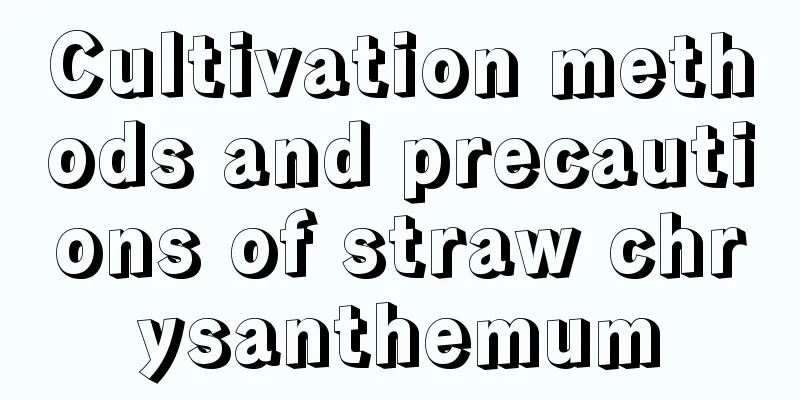Cultivation methods and precautions of straw chrysanthemum

1. Maintenance methods1. Temperature: It is neither cold-resistant nor heat-resistant. The suitable temperature for its growth is around 20 degrees. If the temperature exceeds 25 degrees in summer, it needs to be cooled down. If the temperature is below 5 degrees in winter, it needs to be kept warm. 2. Watering: Spring and autumn are its vigorous growth periods, and it needs to be watered every three days. The temperature is higher in summer and the water evaporates faster, so it needs to be watered every three days. If the water used for watering is tap water, it needs to be dried before use. In winter, you need to control the amount of watering and watering once a week is enough. 3. Fertilization: During the growth period, fertilizer is needed once every half a month. Nitrogen, phosphorus and potassium compound fertilizer should be used, because compound fertilizer has comprehensive nutrition and can meet the needs of the plant in all aspects. Stop fertilizing during the dormant period to avoid fertilizer damage. 4. Light: It cannot accept strong light exposure. Under strong light, its branches and leaves will quickly become dehydrated and the leaves will become dull. During the growing period, six hours of diffuse light per day is sufficient, and four hours of light per day is sufficient during the dormant period. 2. Breeding techniques1. Reproduction: The sowing method is generally used to propagate straw daisy. The collected seeds are sprinkled into the soil with sufficient nutrients and moist soil, and then covered with a thin layer of soil. The moisture of the soil is kept at 50%. It is placed in a warm and dark environment for maintenance. The seedlings will emerge in about a week. After germination, they cannot be transplanted for the time being. You should wait until it grows three true leaves before transplanting. This way the survival rate will be higher. 2. Pruning: When it is in its vigorous growth period, the branches on the top of the plant can be removed in order to concentrate nutrients and promote the growth of side buds. If you find tender buds on the top of the plant, you can also remove them together to prevent the plant from growing too tall. 3. Problem Diagnosis1. Pests: It is more susceptible to pests such as paulownia tortoise shell. When the insects are still in the larval stage, it is necessary to spray some pesticides once or twice a week. 2. Pathology: Catalpa trees are susceptible to carbuncle in humid climates. When the disease occurs, the leaves will fall off, so ventilation needs to be increased during maintenance. If the plants are infected with anthracnose, they can be sprayed with carbendazim. IV. Other issues1. Toxicity: It is non-toxic. Not only is the bark non-toxic but it can also be used, and the leaves have a detoxifying effect. 2. Is it suitable for indoor cultivation: If the potted plants have been treated, they can be cultivated indoors. If it has not been processed, it is not recommended to grow it indoors, because it grows too fast and the plant is too large, which does not meet the conditions for home cultivation. |
<<: Tomato cultivation methods and precautions
>>: Cultivation methods and precautions of Emerald Philodendron
Recommend
How to water the lucky tree
1. Watering method In summer, the temperature is ...
What soil is suitable for Osmanthus fragrans
Osmanthus fragrans is also called thousand-mile f...
Can rose seeds be planted directly? Will the seeds in rose flowers bloom when planted?
Can rose seeds be planted? Rose seeds can be plan...
When and how to plant radish
Radish planting time Water radish is generally pl...
What vegetables are suitable for planting after the beginning of autumn?
After the beginning of autumn, the weather gradua...
Common diseases of Clerodendrum thomsoniae and their control methods
Common diseases of Clerodendrum thomsoniae: leaf ...
How many dwarf sunflowers should be planted in one pot?
How many dwarf sunflowers can be planted in one p...
How long does it take for celery to grow?
Introduction to Celery Growth Celery likes to gro...
Can potassium phosphite be mixed with trace elements (taboos for compound use of potassium phosphite)
Potassium phosphite is a high-quality phosphorus ...
Don’t throw away the pineapple peel after eating it. It can be used as fertilizer without any odor, and it can make your flowers grow rapidly and have lush green leaves!
Peeling the pineapple We usually buy peeled pinea...
How to make and use Chlorophytum fertilizer
Chlorophytum suitable for flower fertilizer If yo...
How to prune peppers and how to prune them
Pepper pruning time When pruning peppers, it is n...
Can money tree be watered with vinegar?
Can I water the money tree with vinegar? Generall...
How to grow roses on the balcony? How to grow roses on the balcony?
It is good to plant roses on the balcony. General...
How many days does it take for watermelon seeds to germinate? How many days does it take for watermelon seeds to germinate?
How long does it take for watermelon seeds to ger...









